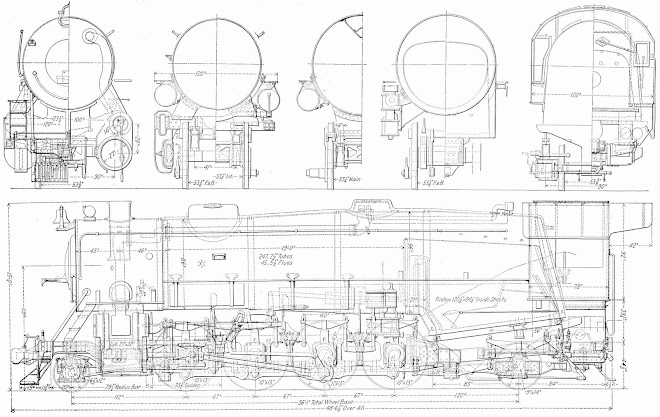Revised: 11/23/12 Subject to Revisions
The expansion link brackets and their mounts had been designed in the earliest stages of learning the Alibre Pro 3D CAD program more than a year ago. Now that the cylinder assembly has been installed it is time to address the brackets and the expansion link itself. On the model the links are about 2" long and pivot between two horizontal supports. The expansion link brackets are in turn mounted between two fairly wide horizontal frames that mount to the frame and extend out beyond the drivers and drive rods. The forward support also mounts the rear of the crosshead guides. The front support is quite complex, thin and fairly large being some 5" wide and nearly 4" high and only a little of 1/8" thick. This part would be a challenge to build on the 3D printer.
Crosshead Guide and Expansion Link Bracket Front Support As Printed
The author revised the design to fabricate the crosshead guide and expansion link bracket support in three parts that would later be glued together to form the overall part. The above photo shows the three part sub-assembly as printed. The top of the part as printed is actually the back side of the part. The bar shown in the middle will join the two ends at left and right.
Crosshead Guide and Expansion Link Bracket Support Parts Before Cleaning
The above photo shows the support material residue on the right hand section which is removed on the left and joining bar at left and top in the photo above. Two angle brackets with angled shoes will mount the overall assembly to the locomotive frame eventually. The author realized that since this and the rear support must join several parts with some accuracy, drilling holes in the frame will await fit checking and fabrication of several other parts that mount on the support. Parts that mount on the support frames will be attached with small 00-90 screws rather than glue so that that portion of the locomotive that support the valve and crosshead can be adjusted as needed. The curved sections are boiler supports. This is a busy part that must support many things: crosshead guides that must align with the cylinder piston and main connecting rod, expansion link which must align with the piston valve via the radius bar and fly crank through the fly-crank rod.
Rear Expansion Bracket Support rail as printed
The rear support for the expansion link support brackets is mounted across the frame and is nearly the same width as the crosshead guide support shown above. This support also supports the boiler along the curved sections that protrude above the bar.
Set of Frame Mounted Supports
The above set of frame mounted supports each provide support for various portions of the boiler as well as other parts of the locomotive mechanisms. The top support is between the front and intermediate driver, the second is between the intermediate driver and main driver and finally the lower is between the main driver and rear driver. Each mounts to the frame with brackets that lie along the top of the frame and support the boiler above on the curved section. The top and middle supports provide attachment for the expansion link brackets between them while the top support attaches the rear of the crosshead guides.
Expansion Link Bracket Set as Printed
The expansion link is a curved cam lever that is supported about 1/3rd of the way back of the first support frame. It pivots to provide proper drive to a rod that in turn moves the piston valve. The pivot is the hole in each bracket. The expansion link is supported by two pivots, one on either side which are formed as a hole in the brackets that lie on each side of the link.
Expansion Link Brackets After Clean-Up
Like all printed parts the expansion link brackets have green ABS support material residue that is removed using the Dremel tool and model knife. The large hole is the expansion link pivot. Not readily seen are four smaller holes, two on each end that will be tapped for 00-90 mounting screws.
Expansion Brackets Being Tapped for 00-90 Screws
The four small pilot holes were hand tapped for the 00-90 screws as shown in the above photo.
Expansion Link Fit Checked in Brackets
The expansion link is a cam shaped to drive the radius rod that connects eventually to the piston valve. The radius rod passes through the middle of the expansion link and rides in the curved slots on either side.
Assembly of Inside Expansion Link Brackets to Front and Rear Supports
Top View of Expansion Link Inner Brackets, Front and Rear Support Assembly
The expansion link inner brackets were then assembled with the front and rear supports as shown above. The brackets are held using small 00-90 screws. They are so small they are nearly invisible in the photo.
Closer View of Expansion Link Bracket Attached to Rear Support With 00-90 Screws
Fireman Side Expansion Link Installed in Brackets
The fireman side expansion link was installed between the bracket pair as shown in the above photo. The link rotates freely around the white pivot that extends through the brackets. The parts are held together with screws so that it can be progressively assembled on the locomotive and disassembled later if needed.
Expansion Link Bracket and Supports Fit Checked on Locomotive
The above photo shows the expansion link bracket and support assembly placed in position on the locomotive frame. The expansion link is well outside the path of the rods and does not interfere. An extension below the bracket on the front support will eventually support the crosshead guides. So far this portion looks to fit well.


































